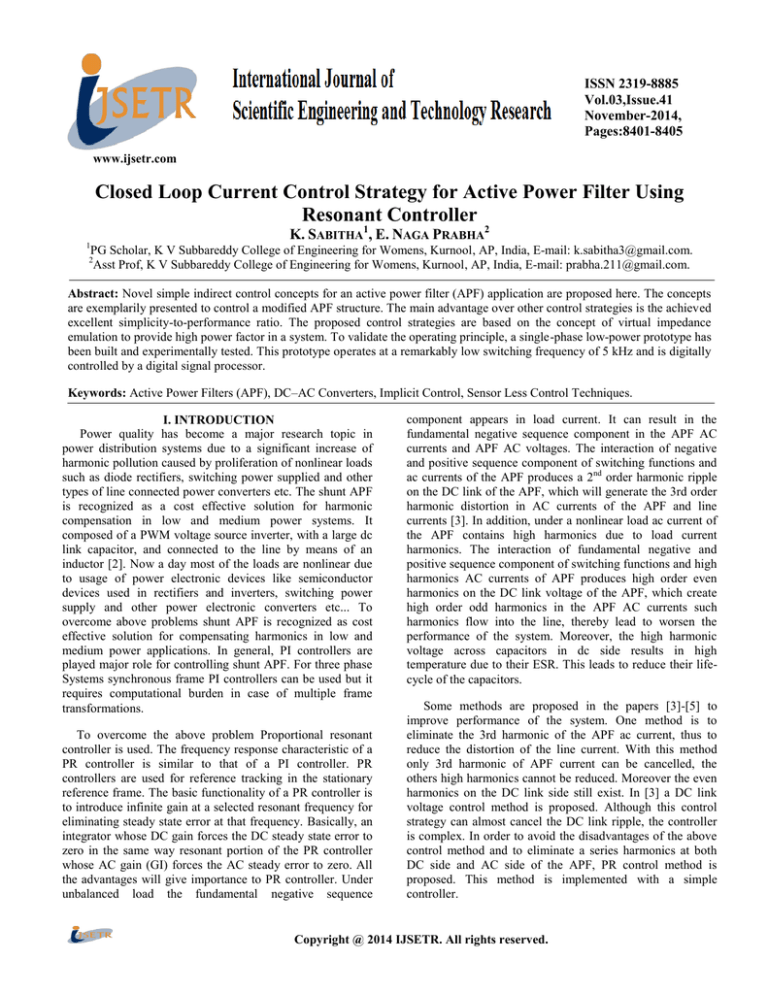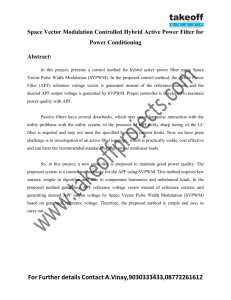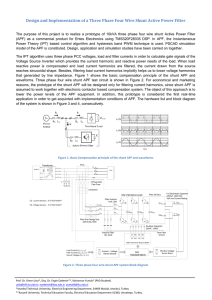
ISSN 2319-8885
Vol.03,Issue.41
November-2014,
Pages:8401-8405
www.ijsetr.com
Closed Loop Current Control Strategy for Active Power Filter Using
Resonant Controller
K. SABITHA1, E. NAGA PRABHA2
1
PG Scholar, K V Subbareddy College of Engineering for Womens, Kurnool, AP, India, E-mail: k.sabitha3@gmail.com.
Asst Prof, K V Subbareddy College of Engineering for Womens, Kurnool, AP, India, E-mail: prabha.211@gmail.com.
2
Abstract: Novel simple indirect control concepts for an active power filter (APF) application are proposed here. The concepts
are exemplarily presented to control a modified APF structure. The main advantage over other control strategies is the achieved
excellent simplicity-to-performance ratio. The proposed control strategies are based on the concept of virtual impedance
emulation to provide high power factor in a system. To validate the operating principle, a single-phase low-power prototype has
been built and experimentally tested. This prototype operates at a remarkably low switching frequency of 5 kHz and is digitally
controlled by a digital signal processor.
Keywords: Active Power Filters (APF), DC–AC Converters, Implicit Control, Sensor Less Control Techniques.
I. INTRODUCTION
Power quality has become a major research topic in
power distribution systems due to a significant increase of
harmonic pollution caused by proliferation of nonlinear loads
such as diode rectifiers, switching power supplied and other
types of line connected power converters etc. The shunt APF
is recognized as a cost effective solution for harmonic
compensation in low and medium power systems. It
composed of a PWM voltage source inverter, with a large dc
link capacitor, and connected to the line by means of an
inductor [2]. Now a day most of the loads are nonlinear due
to usage of power electronic devices like semiconductor
devices used in rectifiers and inverters, switching power
supply and other power electronic converters etc... To
overcome above problems shunt APF is recognized as cost
effective solution for compensating harmonics in low and
medium power applications. In general, PI controllers are
played major role for controlling shunt APF. For three phase
Systems synchronous frame PI controllers can be used but it
requires computational burden in case of multiple frame
transformations.
To overcome the above problem Proportional resonant
controller is used. The frequency response characteristic of a
PR controller is similar to that of a PI controller. PR
controllers are used for reference tracking in the stationary
reference frame. The basic functionality of a PR controller is
to introduce infinite gain at a selected resonant frequency for
eliminating steady state error at that frequency. Basically, an
integrator whose DC gain forces the DC steady state error to
zero in the same way resonant portion of the PR controller
whose AC gain (GI) forces the AC steady error to zero. All
the advantages will give importance to PR controller. Under
unbalanced load the fundamental negative sequence
component appears in load current. It can result in the
fundamental negative sequence component in the APF AC
currents and APF AC voltages. The interaction of negative
and positive sequence component of switching functions and
ac currents of the APF produces a 2nd order harmonic ripple
on the DC link of the APF, which will generate the 3rd order
harmonic distortion in AC currents of the APF and line
currents [3]. In addition, under a nonlinear load ac current of
the APF contains high harmonics due to load current
harmonics. The interaction of fundamental negative and
positive sequence component of switching functions and high
harmonics AC currents of APF produces high order even
harmonics on the DC link voltage of the APF, which create
high order odd harmonics in the APF AC currents such
harmonics flow into the line, thereby lead to worsen the
performance of the system. Moreover, the high harmonic
voltage across capacitors in dc side results in high
temperature due to their ESR. This leads to reduce their lifecycle of the capacitors.
Some methods are proposed in the papers [3]-[5] to
improve performance of the system. One method is to
eliminate the 3rd harmonic of the APF ac current, thus to
reduce the distortion of the line current. With this method
only 3rd harmonic of APF current can be cancelled, the
others high harmonics cannot be reduced. Moreover the even
harmonics on the DC link side still exist. In [3] a DC link
voltage control method is proposed. Although this control
strategy can almost cancel the DC link ripple, the controller
is complex. In order to avoid the disadvantages of the above
control method and to eliminate a series harmonics at both
DC side and AC side of the APF, PR control method is
proposed. This method is implemented with a simple
controller.
Copyright @ 2014 IJSETR. All rights reserved.
K.SABITHA, E.NAGA PRABHA
II. DESIGN OF ACTIVE POWER FILTER
A. Active Power Filter
In [9] an inverter operates as active inductor at a certain
frequency to absorb the harmonic current. But the exact
calculation of network inductance in real-time is difficult and
may deteriorate the control performance. The shunt active
power filter acts as active conductance to damp out the
harmonics in distribution network [11].The study of the
Shunt APF can be classified into three categories;
Harmonic Detection: Generally Shunt APF is connected
across the load for compensation purpose. But now a day
nonlinear loads are increased due to the usage of power
electronic devices. These loads will produce higher order
harmonics into the line current the harmonic detection
method to calculate the reference currents of the shunt active
power filter.
Structure of Shunt APF: The Voltage source Inverter with
six IGBTs is used for the Shunt APF. Switching pulses of six
IGBTs can be generated by the PWM / Hysteresis controller.
PWM / Hysteresis Control: This controller can be used to
control the compensating currents. There are many
techniques to control the compensating currents such as the
Hysteresis current control, the Pulse width modulation
control.
B. Objective of Harmonic Compensation
Objectives of harmonic compensation are as follows;
Eliminate real power oscillations
Power factor improvement
Eliminate current harmonics
Provide harmonic damping
These objectives can be done by configure the Active
Power Filter.
C. Active Power Filter Configuration
AF’s can be classified based on converter type, topology,
and the number of phases. The converter type can be either
CSI or VSI bridge structure. The topology can be shunt,
series, or a combination of both. The third classification is
based on the number of phases, such as two-wire (single
phase) and three- or four-wire three-phase systems [8].
Coming to the unbalanced load issue are shown in Fig.1, the
presence of fundamental negative sequence component in the
load currents can affect the APF system performance. This
negative sequence, if not blocked by the APF current
reference generator, will produce a fundamental negative
sequence component in the APF currents due to the
proportional gain of the current controller. That will produce
a 2nd order ripple in the DC-link voltage, which will generate
harmonic distortion in the source currents. Therefore, if the
unbalanced load compensation is not required, the circulation
of the fundamental negative sequence currents in the APF
must be completely blocked to avoid distortion of the source
currents [3].
Fig.1. Basic current harmonic compression scheme of an
unbalanced load using a shunt APF [3].
Voltage and current harmonics has become a serious
problem in transmission and distribution systems in recent
years. To solve the current harmonic related problems,
passive filters connected in several circuit configurations
present a low cost solution. However, passive filter
implementations to filter out the current harmonics have the
following disadvantages:
Possibility of resonances with the source impedance
Supply impedance dependent system performance
Fixed compensation
In order to diminish the preceding disadvantages of the
passive filters, active power filters (APF) have been worked
on and developed in recent years. Elimination of the current
harmonics, reactive power compensation and voltage
regulation are the main functions of active filters for the
improvement of power quality is shown in Fig.2. There exist
several active power filter topologies in the literature in
accordance with their circuit configurations and connection
types [2].Among these configurations, conventional parallel
voltage source active power filter is widely used. The DC
link capacitor voltage is required to be higher than the peak
value of the utility voltage; otherwise, the generated
compensation currents cannot be injected to the mains [3].
So, for high power applications, the required high DC
link voltage restricts the active power filter implementations
due to the increase in the losses, rating and the total cost of
the APF. As a result, various hybrid filter topologies have
been developed which combine the advantages of both the
passive and the active filters [4]. Within these topologies,
shunt hybrid filters formed with the use of a three phase
voltage source PWM inverter and a series connected LC
passive filter are superior to the conventional shunt APFs due
to the reduced DC link voltage and the converter rating. The
series connected LC filter absorbs the current harmonics
arising from the non-linear load; however, the filtering
characteristic of just the passive filter itself is not
International Journal of Scientific Engineering and Technology Research
Volume.03, IssueNo.41, November-2014, Pages: 8401-8405
Closed Loop Current Control Strategy for Active Power Filter Using Resonant Controller
satisfactory. Hence, active filter is used to improve the
active filters and shunt active filters are mainly used for
current related compensations like reactive power, current
filtering performance of the overall system.
unbalance, etc,.
In this paper, a hybrid filter formed by a low-rated APF
and a LC passive filter tuned to 350 Hz is presented. The
proposed filter ensures a low DC link voltage and a superior
filtering performance by the applied feedback and feed
forward control methods. In addition, no switching ripple
filter is used since the LC filter also operates as a switching
ripple filters at high frequency. The startup procedure used in
the laboratory and the experimental results obtained from a
300V laboratory prototype are also presented to show the
effectiveness of the overall system.
Fig.3. Series-Shunt Active Filters.
Fig.4. Voltage Source Inverters.
Fig.2. (a) Voltage Source APF (b) Hybrid Power Filter.
III. TOPOLOGY OF ACTIVE POWER FILTER
Active Power filters are basically classified in to three
types: Single phase, three phase three wire and three phase
four wire systems to meet the requirements of the nonlinear
loads in the distribution systems. Single phase loads, such as
domestic lights, TVs, air conditioners, and laser printers
behave as nonlinear loads and cause harmonics in the power
system. Many configurations, such as active shunt filter as
shown in Fig 2(a), the active series filter as shown in Fig.2
(b) , and combination of shunt and series filter as shown in
Fig.3 has been developed. This topology has been called the
Unified Power Quality conditioner. The above mentioned
APLC’s either based on a Voltage source inverter (VSI) with
capacitive energy storage Fig.4 or Current source inverter
(CSI) Fig.5 with inductive energy storage devices. Both
voltage source inverters and current source inverters are used
to compensate voltage and current harmonics under all the
three categories. They are also used for the compensation of
reactive power, unbalanced current and voltage, neutral
current voltage spikes, voltage flicker and for regulation. The
voltage related compensations (voltage unbalance, voltage
flicker, voltage regulation, etc) are carried out using series
Fig.5. Current Source Inverters.
A. Controlling System
The main component in the APF is the control unit.
Controlling of APF is implemented in three stages:
First stage can be called as the signal conditioning
stage. The essential voltage and current signals could be
sensed using power transformers, Hall Effect sensors
and isolation amplifiers to gather accurate system
information. The instantaneous voltage and current
signals are useful to monitor, measure and record
International Journal of Scientific Engineering and Technology Research
Volume.03, IssueNo.41, November-2014, Pages: 8401-8405
K.SABITHA, E.NAGA PRABHA
various performance indexes such as Total Harmonic
Distortion(THD), Power factor, active and reactive
power, crest factor, etc,.
Second stage is the derivation of compensation signals
stage. In this stage compensating commands in terms of
current or voltage levels are derived based on control
methods and APF configurations. Compensations can
be done either in time domain or frequency domain.
Compensation in frequency domain is based on Fourier
analysis of distorted signal. In time domain a number of
control strategies such as instantaneous reactive power
theory initially synchronous frame synchronous
detection method notch filter and fuzzy logic controller
method, sliding mode controller, etc. Are used in the
development of three-phase AFs .Out of these theories,
Fig.7.
more than 60% research works consider using p-q
theory and d-q theory due to their accuracy, robustness
and easy calculation.
The third stage is the generation of gating signals to the
device of Active filters. The main component of APF is
the solid state devices. Earlier BJTs and MOSFETs
were used. Now-a-days IGBTs are used for medium
ratings and GTOs are used for high ratings. The gating
pulses are generated by current control technique like
sinusoidal pulse width modulation (SPWM), triangular
PWM, hysteresis current control technique, Space
Vector current controller.
Advancement in Microelectronics has motivated new
directions for APF design starting from the use of analog and
digital components to microprocessors, microcontrollers,
digital signal processors (DSP’s) and FPGA implementation.
The analog controllers have some disadvantages such as high
cost, slow response, large size etc., during real-time
implementation. FPGA is given the highest priority as
compared to DSP because of its low cost, faster response,
and application oriented selection of the bit width for the data
resister.
Fig.8.
IV. SUMULATION RESULTS
Fig.9.
Fig.6.
V. CONCLUSION
Novel control strategies for modified shunt APF
architecture have been proposed here. The proposed
strategies were able to guarantee close-to-unity power factor.
Both current and voltage sensor less versions have been
presented, where the voltage sensor less control has been
International Journal of Scientific Engineering and Technology Research
Volume.03, IssueNo.41, November-2014, Pages: 8401-8405
Closed Loop Current Control Strategy for Active Power Filter Using Resonant Controller
analyzed in detail regarding its performance, equivalent
[10] M. Salo, ―AC current sensor less control of the currentcircuits, and stability. The main feature of the strategies is
source active power filter,‖ in Proc. IEEE 36th PESC, Jun.
their extreme simplicity since no complex current reference
2005, pp. 2603–2608.
computations are required. The implicit control loop is
[11] D. Wojciechowski, ―Sensorless predictive control of
another innovative characteristic. In this sense, it was proven
three-phase parallel active filter,‖ in Proc. AFRICON, Sep.
that the proposed strategies are equivalent to explicit current
2007, pp. 1–7.
control strategies employing a resonant-type controller. This
[12] G.-Y. Jeong, T.-J. Park, and B.-H. Kwon, ―Line-voltageexplains the excellent sinusoidal tracking performance. In
sensor less active power filter for reactive power
addition to the resistive behavior, the APF emulates virtual
compensation,‖ Proc. Inst. Elect. Eng.—Elect. Power Appl.,
capacitance and/or negative inductance. Thus, zero mainsvol. 147, no. 5, pp. 385–390, Sep. 2000.
side current phase displacement is achieved. These
characteristics were verified through circuit simulation and in
an experimental setup including a nonlinear rectifier load,
with the APF being switched at 5 kHz. This is a very low
switching and highlights the achievable performance. The
concepts can be easily extended to the control of PFC
rectifiers and three-phase systems.
VI. REFERENCES
[1] Mauricio Angulo, Domingo A. Ruiz-Caballero, Jackson
Lago, Student Member, IEEE, Marcelo Lobo Heldwein,
Member, IEEE, and Samir Ahmad Mussa, Member, IEEE,
―Closed Loop Current Control Strategy for Active Power
Filter Using Resonant Controller‖, IEEE Transactions on
Industrial Electronics, Vol. 60, No. 7, July 2013.
[2] M. Cirrincione, M. Pucci, G. Vitale, and A. Miraoui,
―Current harmonic compensation by a single-phase shunt
active power filter controlled by adaptive neural filtering,‖
IEEE Trans. Ind. Electron., vol. 56, no. 8, pp. 3128–3143,
Aug. 2009.
[3] P. Salmeron and S. Litran, ―Improvement of the electric
power quality using series active and shunt passive filters,‖
IEEE Trans. Power Del., vol. 25, no. 2, pp. 1058–1067, Apr.
2010.
[4] H. Akagi, A. Nabae, and S. Atoh, ―Control strategy of
active power filters using multiple voltage-source PWM
converters,‖ IEEE Trans. Ind. Appl., vol. IA-22, no. 3, pp.
460–465, May 1986.
[5] Y. Tang, P. C. Loh, P. Wang, F. H. Choo, F. Gao, and F.
Blaabjerg, ―Generalized design of high performance shunt
active power filter with output LCL filter,‖ IEEE Trans. Ind.
Electron., vol. 59, no. 3, pp. 1443– 1452, Mar. 2012.
[6] H. Akagi and K. Isozaki, ―A hybrid active filter for a
three-phase 12-pulse diode rectifier used as the front end of a
medium-voltage motor drive,‖ IEEE Trans. Power Electron.,
vol. 27, no. 1, pp. 69–77, Jan. 2012.
[7] M. Aredes, J. Hafner, and K. Heumann, ―Three-phase
four-wire shunt active filter control strategies,‖ IEEE Trans.
Power Electron., vol. 12, no. 2, pp. 311–318, Mar. 1997.
[8] S. Rahmani, N. Mendalek, and K. Al-Haddad,
―Experimental design of a nonlinear control technique for
three-phase shunt active power filter,‖ IEEE Trans. Ind.
Electron., vol. 57, no. 10, pp. 3364–3375, Oct. 2010.
[9] M. Routimo, M. Salo, and H. Tuusa, ―Current sensor less
control of a voltage-source active power filter,‖ in Proc. 20th
Annu. IEEE APEC, Mar. 2005, vol. 3, pp. 1696–1702.
International Journal of Scientific Engineering and Technology Research
Volume.03, IssueNo.41, November-2014, Pages: 8401-8405





